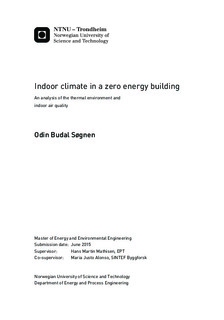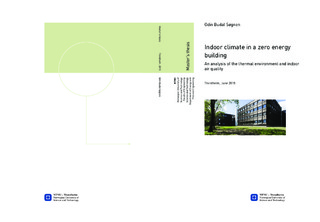| dc.description.abstract | Buildings are responsible for around 40 % of the world s energy use, hence also for huge amounts of climate gases, both directly and indirectly. The building industry needs to become a part of the solution of an energy efficient and environmentally friendly future.
Powerhouse Kjørbo is Norway s first energy-positive office building, and is now in its second year of operation. It is an old rehabilitated office building located in Sandvika, outside of Oslo. The goal of a so-called Powerhouse is to produce more energy than it uses for materials, production, operation, renovation and demolition during the whole of its lifetime. This has been done by the use of highly efficient technical equipment, recycling and reuse of materials and an energy efficient building envelope. Solar panels have been installed on the rooftops of the building and on top of a nearby parking complex. Calculations show that Powerhouse Kjørbo will reach its goal during the building s lifetime of 60 years.
The heating and cooling demand in the building is covered by a geothermal heat pump, with
district heating as peak load when necessary. Motion, temperature and CO2 sensors optimize
the use of lighting, ventilation, heating and cooling. Displacement ventilation with a variable air volume for the open landscapes and meeting rooms is the ventilation strategy. Cell offices use constant air volume displacement ventilation.
The heating and cooling system of Powerhouse Kjørbo is built around a centered heating strategy by waterborne panel radiators at each floor and free cooling through the ventilation system. The heating strategy is dependent on heat distributing equally among the open area and other rooms in the building due to no dedicated heat sources outside the center of each floor.
The measured ventilation efficiency indicates that the strategy works more like mixing ventilation than displacement ventilation in terms of removing pollutants and air exchange. This is not a final conclusion and it is suggested that more work is put into analyzing these results and perform new measurements.
Temperature distribution in the open landscapes vary with the outdoor temperature, by being
more evenly distributed during higher outdoor temperatures. The horizontal temperature differences on the same floor were up to 2.7 °C during the coldest day (-6.3 °C), and up to 1.7 °C during the warmest day (10.8 °C). A cell office with closed door at all times shows a temperature drop of around 2.0 °C between the hallway outside the cell office and inside the cell office during the coldest day at noon. The same is expected, if not a higher temperature drop, in the case of corner meeting rooms if the doors are kept closed.
A survey about the perception of the indoor climate has been conducted for the employees at
Powerhouse Kjørbo and an architecturally similar office building, which has been renovated at a lower standard. Results indicate that employees are generally more satisfied with both the thermal environment and indoor air quality at Powerhouse Kjørbo compared to the other building. Complaints about occasionally low temperatures in the building and poor air quality in meetings rooms have been reported, but apart from that the satisfaction of thermal environment and air quality is high. | |

